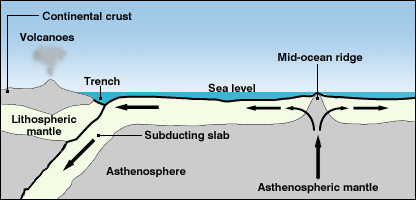The plate tectonics theory has been taken as the base of the formation of the continents on the Earth. But when the plates began to move, had put geologists in a quandary for a long time now. A recent find, described in the journal Science, shows the movements started soon after the planet formed.
The baked and twisted rocks, now part of Greenland, show the earliest evidence of plate tectonics, colossal movements of the planet’s outer shell. The study says plate tectonics was active and familiar as early as 3.8 billion years ago.

Just after the planet earth was born, it got divided into several layers. Our earth comprises of Crust, Mantle and Core. The lithosphere is the topmost layer on which we all live. It is the crust and the upper mantle that form the lithosphere. The lithosphere is broken up into several plates and floats above the asthenosphere. As the plates move, it produces convection currents that help in generating energy in turn results in earthquakes and volcanoes. Today, oceanic crust is created at plate boundaries known as mid-ocean ridges, where magma rises from the asthenosphere through cracks in the ocean floor, cools and spreads away forming island archs. The volcanic archs near the ridges are the youngest; those far away are of older origin. Towards the edges of the oceans the archs becomes cooler, denser and eventually start to sink back into the mantle to be recycled. Most is destroyed at subduction zones (where two plates collide and the lighter one subsides), such as those found along the edge of the Pacific Ocean, where oceanic crust plunges under the buoyant and long-lived continental crust. However, in exceptional cases, when continental crust begins to be sucked into a subduction zone, it clogs the system. Fragments of the sea floor known as ophiloites are preserved when they are scraped on to the land. The continent then pops back up, preserving a little bit of the overriding wedge of oceanic crust and mantle that was on the overriding plate. Ophiolites are found today in Cyprus and Oman.
At their base, crystalline rocks preserve the top layer of the mantle.Above, “fossilized” magma chambers give way to a layer of stacked vertical pipes, known as sheeted dykes and horizontal sills, the conduits through which magma is extruded onto the sea floor as pillow lavas or pillow basalts.
The rocks analysed recently in Greenland are found in an area known as the Isua Belt, a zone of intensely deformed rocks in the southwest of the largest island in the world. The structure of rocks shows the correct sequence of layers found in an ophiolite, except the lowest mantle portion. The sheeted dykes and pillow lavas are clear evidence that these are the ancient remains of sea floor created by processes seen today. This proves that the process of sea-floor spreading is the oldest in the history of the earth formation and the present structure is the oldest sequence of rocks on Earth. The study would further help in raising curtains on various other theories under its sleeve.
via:

